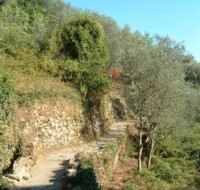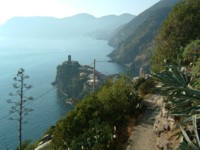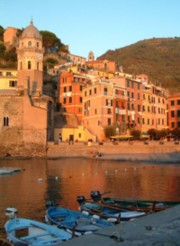By a Hiking Correspondent
I visited the Cinque Terre in mid-September 2003. It was a hot spell with temperatures in the late twenties to thirties, which made some of the midday walking very hard work. I certainly wouldn’t recommend visiting when the weather is any hotter – so try to avoid high summer. Here is a brief account of my walking experience in the Cinque Terre. Note that the times given are how long it took me, walking fairly briskly (apart from a bit of note-taking), and may not be accurate estimates for others.
Find and book hotels in Liguria. With location maps and guest reviews.
Cinque Terre Walking Tips
1. Buy the Cinque Terre Card – you’ll probably find it useful, and it’s only fair to show your support for the environment you are enjoying.
2. Always carry a bottle of water – you’ll need it. In each village there are taps or fountains where you can refill your flask with drinking water (by the stations and usually in other locations too).
3. Don’t rush. The slopes and steps are hard work. Have plenty to drink, and avoid the hottest (middle) part of the day, if necessary.
4. Remember the strain that the landscape is being put under by the weight of visitor numbers. Stay to paths, don’t leave litter and respect the other walkers on the single-file paths.
5. Carry timetables for the trains, the boats and the village buses with you – they really help with planning (especially if you get tired and want to duck out of walking a stretch).

Walking between the Cinque Terre
Riomaggiore – Manarola
(20mins) After leaving La Spezia at lunchtime, it seemed like a good idea to eat in Riomaggiore. On the pretty street leading uphill from the station’s access tunnel there were a huge range of places to choose from; offering anything from sit-down meals to a cheap slice of focaccia. A spot of refuelling and research, and then it was onto the famous coastal footpath.
The walk started extremely unpromisingly. This is a popular stretch of path, known as the Via dell’Amore (Path of Love). Its popularity is perhaps partly due to the fact that it only takes about twenty minutes. It was very disconcerting to begin a walk by being asked to show a ticket – in the local context, given the visitor numbers, it makes sense, but it’s not a typical start to a walk. First impressions did not improve as I found myself on a path paved like a garden patio, a good two metres wide with big metal railings and warning signs to stop me recklessly leaping into the sea. The cliffs above were obscured with thick steel safety meshes – one could only hope that this is not the future of an accessible countryside. This stretch was fine for the mobility-impaired and those with small children (there was even a bar and a furnished picnic area), but not so good for those wanting to feel the dirt under their boots. There were, however, one or two good spots for swimming from the rocks where tourists were basking like pink seals.
Manarola – Corniglia
(1hr15mins) This is where things began to get more interesting. Manarola was pleasant enough; rather similar to Riomaggiore. The town looked rather more modern and less atmospheric; but it was 2.45pm and with only one short stretch accomplished I decided to press on rather than sightsee. Dodging a group of tourists and negotiating a spot of schizophrenic signposting, I found myself on a more open stretch of pathway skirting not far above sealevel, fairly exposed, with real dirt and stone underfoot. The views were impressive, and the villages hovering ahead seemed impressively distant. A long strip of shingle beach ran along the approach to Corniglia. A strange, apparently abandoned complex of beach huts lined the path below the railway, rather like an odd prison camp. There was apparently a bus up to Corniglia from the town’s railway station. Not having a timetable, and feeling that it would be cheating, anyway, I resolved to walk up the zigzag stairway I could see ahead. In surprisingly little time I was up on the road leading into the heart of the town. It was 4pm. The path onwards to Vernazza lay ahead, but for the moment I turned left and headed in search of gelato and drinking water. The town was pretty – narrow lanes with towering buildings painted in the warm colours I was beginning to recognise.
Corniglia – Vernazza

(1hr30mins) From Corniglia the path began to be lovely, about as attractive as a cliffpath can get. The route was obviously an old one, walled and worn with hard-packed soil or stone slabs underfoot and over streams. Winding through ancient cultivated terraces, olive groves and woodland, this was much more the kind of thing I’d imagined. It was also the sort of thing that gives your leg muscles good, serious exercise. After the first valley the path began to rise.. and rise.. until it became an endurance test. Fortunately, near the highest bend sat a little cluster of houses (presumably with some other form of access from a road above) and a very welcome bar, where the friendly owner talked politics and royalty. Exhausted hikers could gulp down fruit juices while admiring the breathtaking view back towards Corniglia from the wide window.
After the bar the path began a welcome descent. Through trees and more terraces it began winding down towards Vernazza, a cluster of rooftops around a tiny harbour. It was 5:45pm, and it seemed like time to call it a day for walking. So I explored the steep lanes of the town, admiring the weatherbeaten orange facades. Another steep climb led up to the Castello Doria, which offered good views down over the harbour. The benches in the waterfront piazza offered a welcome rest and glimpses of goods trains vanishing into the cliff tunnel, laden with shiny new cars. After a spot of photography, and watching the boats come and go, it was time for an early dinner. Choosing the restaurant whose outdoor tables had the best view of the setting sun, I enjoyed an olive pizza and local wine, before jumping on a train for the short journey back to La Spezia and my hotel.
Monterosso – Vernazza
(1hr20mins) Due to the vagaries of the trains, I walked the final stretch of coastal footpath in the opposite direction. Starting at Monterosso, the most northerly of the Cinque Terre, I passed the beaches where bright umbrellas were already lining up for another day of sunshine. It was nearly 11am, and the path was fairly crowded. The steep steps that soon materialised saw us walkers overtaking then re-overtaking each other, as we managed the climb at different speeds, pausing for breath at alternate intervals. Through more walled terraces and some woodland providing welcome respite from the heat of the sun. After some pleasant contouring, the path began a steep descent towards Vernazza – the views at this point were exceptional. I reached the harbour at 12:20 – just in time to catch the boat southwards to Portovenere, bidding farewell to the Cinque Terre.
More Hiking
The coastal path is footpath number 2, and is marked by red and white paint splashes and the number 2. Other paths head upwards to higher levels – these are less busy, non-payment paths, but should be similarly numbered and waymarked.
I had only spent a few hours on the coast, but there seemed plenty to return for. The less-trodden paths were a tempting prospect, despite the amount of climbing involved. And, from the boat, the stretch of coast between the Cinque Terre and Portovenere looked very appealing. Some incredibly dramatic houses clung to rocks, apparently defying the laws of gravity. The footpath does continue along this stretch; and it certainly seems worth investigating.
Go it alone
One final note: as a solo female traveller I felt comfortable and safe on these paths, and I was made perfectly welcome at the restaurant in Vernazza where I ate. Such is the air of cameraderie between the visiting walkers that I ended up chatting to the American couple at the next table.
Useful links
